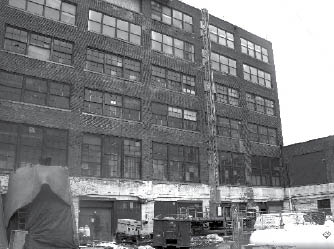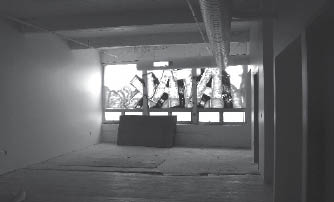Artspace Open for Tours
by Gabe Armstrong

Breaking down barriers though Art,” might come off sounding like one of those lofty mission statements that is easily dismissed as pretentious banter. But in true, literal form, this loopy phrase will soon mean a lot on Buffalo Near East Side.
The Midtown neighborhood straddling Main Street between East Utica and Best Streets has been part of the long dividing line between the East and West Sides of the city. Lining this stretch of Main Street are a number of large, former industrial and warehouse buildings, most of which have sat in a near lifeless state for a generation or more.
The nationally renowned, non-profit real estate developer Artspace, based in Minneapolis, in collaboration with Savarino Construction, has an impressive rehab underway for 1219 Main Street, the five-story historic Buffalo Electric Vehicle Company building, originally built in 1911. It will be transformed into 60 units of affordable live/work housing for artists and their families. Thirty-six units will be in the actual building, while the rest will be in newly constructed units behind it. The units will be one-, two- and three-person occupancy, and rents will range from $236 to $769 per month.
Along with the residential spaces, the front of the building along Main Street will have 10,000 square feet of commercial space. This will be broken up into multiple storefronts to host businesses that sell goods and services relevant to the new artist community.
What Artspace aims to create is a massive artist colony, featuring spacious loft apartment units along with plenty of communal space. All of this in a neighborhood that most people in region rush by at 40 miles per hour.
Andrew Commers, one of Artspace’s project directors, hopes that the plentiful common areas will spur intense creative collaboration and artistic cross-pollination. He says that many Artspace buildings have helped to catalyze urban revitalization in their surrounding neighborhoods, as well as provide permanently affordable space for local residents.
This project has attracted much fanfare on the national stage and was featured as a part of HGTV’s Restore America series. In the TV spot senator Hillary Rodham Clinton, who had a big part in securing federal funding for the project, summed up Artspace’s efforts in these words: “Honor the past, invest in the present and imagine and create in the future.” Mayor Byron Brown enthusiastically called this a “win-win proposition.”
“The mission of Artspace Projects is to create, foster and preserve affordable space for artists and arts organizations,” Commers says. “As with our other 18 completed projects, Artspace entered at the invitation of the community. In early 2004, the City of Buffalo asked Artspace to explore a project in Buffalo, and the positive impact of our first visit led to an ongoing pre-development scope of work and the final project.”
Perhaps the most interesting elements of this project lies not within the building itself but behind it. Out in back of the property is a large space where 24 artist units are being built in the form of architecturally contemporary four-plexes arranged along a series of communal pathways and green spaces. There will be six of these buildings, all clad in gray brick.
Artspace’s definition of “artist” is not limited to those who produce visual arts. According to Commers, inhabitants practicing many creative occupations will fit the bill in terms of the residency requirements needed to score one of these units. Painters, musicians, dancers, digital designers and sculptors all fall under this inclusive umbrella. Prospective residents will be interviewed, focusing not on a subjective evaluation of an artist’s work but on the perceived commitment to his or her craft.
“The artist selection committee will determine whether an applicant can demonstrate an ongoing dedication to their art,” Commers says. “While the artists in our buildings derive their income from varied occupations other than their art, they qualify themselves as an artist by demonstrating this dedication.“

There is also a set of income requirements for prospective tenants. These are all subsidized units geared toward artists who don’t exactly make a fortune. For example, an applicant trying to qualify for for a one-person unit can only earn up to $20,400 per year—50 percent of the area median income (AMI).
The scope of this project has the potential to extend far beyond the rehabbed industrial building and the new-build units in back. Many have sincere hopes that the Midtown neighborhood behind Artspace will undergo a renaissance once the project is complete and the neighborhood is full of budding artists. The mere prospect of this project has garnered plenty of attention to the neighborhood. It has been written and blogged about frequently over the last two years.
Aesthetically, Midtown looks like the Elmwood Village’s long-lost cousin; the architecture is very similar. The streets are lined with substantial Victorian and Queen Anne style homes. However, instead of trendy boutiques, cafes and immaculately restored historic homes, Midtown, like much of the East Side, is marred by abandoned houses, vacant weedy lots and a general aura of decay and disrepair.
“Midtown is primed to become the new arts community in Buffalo,” says Stevan Stipanovich, an urban planner who co-authored a master plan for the neighborhood.
“Much like Allentown 30 to 40 years ago, Midtown has the attributes to become an artist village,” he says. “It possesses inexpensive real estate, great connections to in-demand neighborhoods like Allentown, the Medical Campus and Elmwood Village, and is along the Metro Rail line.”
Stipanovich cites the soon to be completed Buffalo Academy of Visual and Performing Arts as a key component in making Midtown a vibrant, arts-oriented neighborhood.
“The ability to be creative with architecture and planning is due to the current conditions of the neighborhood,” Stipanovich says. “Midtown is poised to go a few steps further in artist development than Allentown.”
Flanking Artspace directly to the south is Coe Place, a tiny, one-block lane most people barely notice while speeding down Main Street. This narrow street is lined with a collection of small, eclectic Queen Anne houses built around 1890. Condition of these homes range from decaying to mid-rehab. Stipanovich sees Artspace and the rebirth of Coe Place as catalysts for making Midtown a desirable neighborhood.
“Artspace is already generating interest by people who never had any interest in investing on the East Side to invest in streets such as Coe Place and Ellicott Street,” he says.
Currently Artspace has completed projects in cities such as Pittsburgh and Bridgeport, Connecticut. Buffalo is Artspace’s first project site in New York. Commers says Artspace is looking forward to continued work in the state, with development projects underway in East Harlem and Patchogue on Long Island.
There will be an information session and tour for prospective tenants on April 19, 5-7:30pm, at 1219 Main Street. The project will be completed later this spring and interviews for residency will begin then. For more information, visit artspacebuffalo.org.
|
Issue Navigation> Issue Index > v6n15: Open House (4/12/07) > Artspace Open for Tours This Week's Issue • Artvoice Daily • Artvoice TV • Events Calendar • Classifieds |









 Current Issue
Current Issue